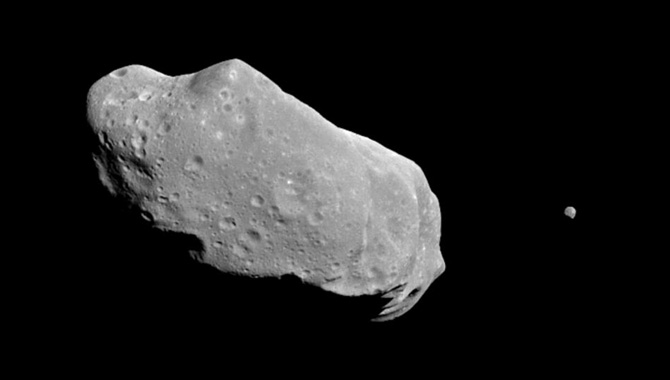
The Touch-And-Go Sample Acquisition Mechanism (TAGSAM) undergoes testing at the Lockheed Martin facility.
Photo Credit: Lockheed Martin Corporation
In September 2016, NASA will launch its first mission to orbit, study, and sample an asteroid in order to learn more about the origins of the solar system and life on Earth.
Our solar system emerged 4.6 billion years ago when a cloud of gas and dust in the Milky Way collapsed. That cloud formed primitive bodies, now known as asteroids, some of which then coalesced and accreted to create planets. Studying these primitive bodies may provide novel insight into how the solar system and Earth developed.
“One such body is Bennu. This is a dark asteroid that we have found and that we’re going to hunt down, we’re going to orbit, we’re going to take a good look at it, and we’re going to bring back a sample,” said Jim Green, director of the Planetary Science Division at NASA.
To achieve this, NASA is launching the Origins, Spectral Interpretation, Resource Identification, Security-Regolith Explorer (OSIRIS-REx), the third mission in the agency’s New Frontiers program. The spacecraft, which is about the size of an SUV, will leave Cape Canaveral, Florida, on September 8, 2016. The mission supports five science instruments: the OSIRIS-REx Camera Suite (OCAMS), the OSIRIS-REx Laser Altimeter (OLA), the OSIRIS-REx Thermal Emission Spectrometer (OTES), the OSIRIS-REx Visible and Infrared Spectrometer (OVIRS), and the Regolith X-ray Imaging Spectrometer (REXIS).
“The OSIRIS-REx spacecraft is actually the result of combining a couple of very successful heritage events,” said Rich Kuhns, OSIRIS-REx program manager with Lockheed Martin Space Systems. “The spacecraft itself…is an evolution that started on MRO, or the Mars Reconnaissance Orbiter. It came through the Juno spacecraft and the MAVEN spacecraft, and we’ve adapted [it] to hold the sample return capsule.”
Nearly two years after launch, in August 2018, OSIRIS-REx will spy its target for the first time. “Then, over the next two years, we will approach Bennu, map it, orbit it, study it, and pick the safest and most scientifically interesting place to pick a sample from before going in and attempting to sample,” said Gordon Johnston, OSIRIS-REx program executive at NASA.
Bennu was selected for its accessibility, its size, and its composition. “Bennu is a carbon-rich, near-Earth asteroid that holds the record of the formation of the solar system and can answer some fundamental questions about the origins of our solar system and our planet,” added Johnston.
“This mission follows on the very successful Stardust mission. In fact, we’re using the same sample return technology for OSIRIS-REx. Stardust told us a lot about comets, which formed way in the outer part of the solar system. OSIRIS-REx is bringing back samples closer to home,” said Dante Lauretta, OSIRIS-REx principal investigator with the University of Arizona. These samples will “help us understand why we are here, how we are here, and how likely it is that this kind of process—origin and evolution of life—may have occurred elsewhere in the solar system and even throughout the galaxy.”
Jeff Grossman, NASA OSIRIS-REx program scientist, said that the mission “also advances our more practical goals of understanding the resources of the near-Earth solar system as well as the hazards, and characterizing those and better understanding the processes that are involved.”
The OSIRIS REx spacecraft will orbit and study the asteroid before selecting a sample site and moving in to obtain the sample. Although it won’t land on Bennu, it will make contact with the asteroid using the Touch-And-Go Sample Acquisition Mechanism (TAGSAM), a sampler head with an articulated arm. The TAGSAM will touch the surface for about five seconds as it removes material from Bennu.
“We’re trying to get at least 60 grams, which is about two ounces, of sample from Bennu. But we could get much more. And we could try up to three times before ultimately delivering it back to Earth,” said Grossman.
After acquiring the sample, the mission will stow it in the sample return capsule (SRC), which is scheduled to arrive back on Earth in September 2023. Twenty percent of the sample will be curated and studied by the OSIRIS-REx team at Johnson Space Center (JSC). Four percent will be curated by the Canadian Space Agency (CSA), which is a major partner in the mission and provided the OLA instrument. Another .5% of the sample will be studied by scientists from the Japanese Aerospace Exploration Agency (JAXA), as part of the cooperation between NASA and JAXA on the OSIRIX-REx and Hyabusa 2 missions.
“But three-quarters of the sample will be set aside for future researchers—for the science questions we haven’t figured out to even ask yet and the science laboratory instruments that we haven’t even developed yet,” said Johnston. “And that’s really the rich legacy of a sample-return mission.”
OSIRIS-REx will have implications not only for scientists and others interested in learning more about the origin of the solar system and of life on Earth, but also for companies interested in future asteroid mining.
“OSIRIS-REx is really a trail blazer for all future small body missions. We’ve developed an enormous amount of proximity operations technologies, both on the spacecraft and on the ground system, to overcome the challenges of accurately navigating a vehicle like this in the microgravity environment. In fact, it’s one of the key challenges that the OSIRIS-REx mission faces. So any team that’s going out there and planning to interact intimately with an asteroid, […] they’re going to take great advantage of all these pioneering techniques that OSIRIS-REx has developed,” said Lauretta.
“It really is a great adventure,” he added. “We’re going out into the unknown [and] we are bringing back scientific treasure.”
Watch this video to learn more about the OSIRIS-REx sample-return mission.









